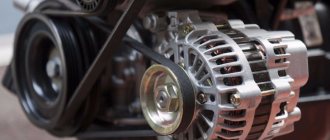When there is not enough money for a new car or a suitable model cannot be found, some decide to create their own car from spare parts and components. If no one can restrict you during assembly, then you cannot immediately move on the invention; you must go through the registration procedure.
Fortunately, in Russia this is possible and quite easy to do. Today we will talk about how to register a homemade trailer for a car and how to register the car itself with the State Traffic Safety Inspectorate (State Traffic Inspectorate) of Russia.
What homemade vehicles may not be registered?
Not all home-made cars are subject to registration. Only vehicles whose maximum weight does not exceed 350 kg must be registered. In addition to a self-made passenger car, home-made motorcycles, trailers and semi-trailers are also subject to registration.
In addition, there is no need to register home-made vehicles that are made from parts brought to the Russian Federation for a period of no more than 6 months. They must be accompanied by all documents that confirm their legal use.
All parts must be certified. If the manufacturer of a home-made vehicle makes changes to the design and parts, he will be re-certified. That is, you do not need to make any changes to the purchased parts.
Certification is one of the important stages, which is the basis for registering a vehicle with the traffic police.
Without this document, it will not be possible to obtain a car registration certificate and license plates, therefore, before contacting Rostechregulirovanie, you must study in detail the Order of Rostechregulirovanie, which approved changes to the Rules for carrying out work in the Certification System of Motor Vehicles.
These rules list new requirements that apply to the certification procedure.
Particular attention should be paid to the following points:
- presence of seat belts;
- operation of the brake system;
- presence of mirrors.
If certification is refused, the citizen will be provided with recommendations on necessary design changes that must be taken into account before re-evaluating the homemade vehicle.
Thus, registering a homemade car will require a lot of effort and documents, starting with examinations and ending with obtaining a certificate of conformity.
However, having received all the documents, you can register your car and safely start driving.
Now, knowing the main points and stages of registration, you can register a home-made car and calmly leave, however, provided that you already have a driver’s license.
Driving this type of transport is permitted on public roads, provided you have all the necessary documents - a vehicle registration certificate, as well as a vehicle passport and license plates.
As it may seem, the procedure for registering such a vehicle will take a lot of time and money.
If you don’t have an idea about the procedure itself, you can get confused, and this will accordingly take up more time and money. Therefore, follow the advice in this article and drive your masterpiece, surprising other car owners.
Be careful and good luck on the roads! You will find the deadlines for registering a car under a purchase and sale agreement in the article: violation of the deadlines for registering a car.
What is temporary termination of vehicle registration, see the information.
Replacing a vehicle registration certificate when changing your last name is discussed on the page.
Certification standards
To register a homemade car, you first need to be certified. The requirements defining the procedure are approved in the corresponding order of Rostekhregulirovaniya. Now cars are evaluated according to a simplified scheme - as a vehicle that is produced in “small series”. A small series means a single copy of a machine.
This is a little trick of the state, with the help of which it was able to get rid of the import of so-called designers. The number of cars in a small batch is carefully checked. It is clear that the author of a homemade car that he assembled for himself will not produce more than one vehicle of the same type. Thus, it is no longer profitable for someone involved in industrial assembly to work according to such a scheme. It is not possible to go through the certification procedure again.
European requirements
The requirements for home-made cars are no lower than the standards established for production cars. There are no “indulgences”; in addition, such vehicles must comply with the standards of the Economic Commission for Europe. True, certification of small batches is carried out according to a reduced list of requirements. However, this is still a fairly serious procedure that not all homemade products undergo.
The video shows a homemade Ukrainian sports car:
In accordance with a document approved by the European Commission, vehicles are checked for compliance with the following requirements:
- traumatic safety of the steering wheel;
- braking performance;
- reliability of seat belts and their attachment points;
- the quality of glass and rear-view mirrors, as well as the correctness of their installation;
- availability of lighting devices, light signaling;
- good machine controllability;
- high car stability;
- low level of harmful substances in the cabin;
- low internal noise level;
- low level of harmful substances in the exhaust pipe.
All these requirements apply to passenger cars manufactured independently.
Procedure
You need to start with the requirements for the design of the car. They are put forward by the testing laboratory. It also issues a conclusion on the conformity of the design of your car. There are certain parameters that must be met. Therefore, we recommend that you first agree on the design of the machine by contacting the Automotive Research Institute. At the same research institute, your vehicle will be tested, after which you will be given a test report.
For each car part, you are required to present a document that confirms the legality of its acquisition. If you have assembled a vehicle from the components of an old car, you must deregister it in advance and obtain a certificate about this. If you bought your previous car second-hand, attach a notarized sales contract to the documents. You will need to present all this to the traffic police.
Once you receive the test report, you need to go to the Highway Safety Institute. This authority will issue you with a conclusion that your car is safe to drive in the city and its design complies with established standards. To receive such a document, you must provide a test report. Certification must be carried out within a month after you submit the corresponding application to government authorities.
Homemade McLaren F1 car
After the work has been done, you can go to the MREO. There you will be given a decision stating that your car does not have an identification number. Then you will need to go with this paper to the forensic bureau, where they will prepare a referral for you to the traffic police to assign an identification number to the car. There you will have to present the following documents:
- passport of a citizen of the Russian Federation;
- opinion from the Institute for Highway Safety;
- conclusion of a forensic expert from the MREO.
The traffic police will assign an identifier to the car and prepare a conclusion about the number. After the number is filled in, you must go to the MREO in your homemade car, taking all the documents received during the procedure. Then your vehicle will finally be registered.
Please note that you will have to pay state fees for each document. After registering the car, you will receive a technical passport. It will indicate “homemade” in the “Brand” column. “Special marks” may indicate which model your car was based on.
Video review of homemade cars of the USSR:
About trailers
If you plan to register a trailer or semi-trailer, the conditions for the procedure change slightly. You will need to purchase a tow bar and present the purchase receipt to the traffic police. In addition, you will need to provide a technical passport of the vehicle with which the trailer will be used.
Necessary documents for registration
A home-made car is registered with the traffic police on a par with serial models, but the list of documents differs from standard cases. You will not be able to present your PTS, so you must provide:
- Certificate of safety of vehicle design from Rosstat.
- Certificate of assignment of VIN code from NAMI.
- A purchase and sale agreement for units, assemblies, or another production vehicle that was used to create a homemade car.
- A written explanation of the origin of the parts used, as well as photographs of all stages of assembly - in the absence of a purchase and sale agreement.
- A certificate stating that the production car used as the base for a home-made vehicle was previously deregistered.
- Technical description of the vehicle.
- OSAGO policy.
- Receipt for payment of state duty.
Registration with the traffic police
The results obtained during the test are provided to the MREO. The purpose of visiting this organization is to obtain an identification number that will be stamped on the body of your car.
Your next stop is the forensic office, where you will receive a referral to issue an identification number . You need to present the following documents to this authority:
- Passport.
- Conclusion of the traffic police.
- Conclusion of an MREO specialist.
Experts may require you to provide the car assembly process in the form of photos and drawings. For each part you need to have a document proving their legal purchase.
If your car uses self-made parts that do not fit into any design standards, give a description of them in free form and indicate any method of receipt: donated, found, exchanged.
IMPORTANT. The more documents proving the assembly of the car from legally purchased parts you provide, the more likely it is to obtain permission to register it.
Collect any little things, even store receipts for every item. As soon as the number is stamped on the body of your car, go again with a package of documents to the MREO and complete the registration. Now you will be given STS and license plates .
Thus, you will have to visit the following authorities:
- The certification center is the closest to your place of residence.
- Traffic Safety Institute.
- MREO
- traffic police
- Bank.
And also learn about how to register: motorcycle, snowmobile, ATV, scooter, moped, scooter.
A little history
Making homemade cars has become popular for a reason. This was preceded by certain historical conditions. The fact is that during the Soviet Union, cars were not produced that would meet the requirements of a specific group of consumers - only mass models were produced. In this regard, our craftsmen created cars with their own hands, from improvised means.
Then, from three old non-working machines, one new one was assembled. In villages, enthusiasts converted passenger cars into trucks. They independently lengthened the bodies and increased the load-carrying capacity of the vehicles, since at that time trucks were not provided for personal use. Craftsmen even created amphibians that were able to overcome water obstacles. And all in order to simplify your life.
There were also aesthetes who were concerned not only with the technical and operational characteristics of cars, but also with their appearance. They created a wide variety of vehicles, including sports cars. All these masterpieces were displayed at exhibitions and drove quite legally on city roads.
Homemade trailer from a broken car
During the Soviet period, homemade cars were not prohibited. Restrictions appeared in the eighties. They concerned power (50 hp per ton) and dimensions (4.7 m - length; 1.8 m - width). But car enthusiasts of that time used some tricks. For example, they registered SUVs under the guise of tractors with Rostekhnadzor. Thanks to the lenient requirements for home-made products, a large number of hand-built vehicles were registered during that period.
Ban on homemade cars
In 2005, registration of home-made cars was banned altogether. This was argued by the need to develop clear requirements and standards for such vehicles. However, the real reason for this, most likely, was the emergence of a new phenomenon in the automobile markets - the sale of “construction sets”. The scheme was simple: to evade taxes, craftsmen imported foreign cars into the Russian Federation in the form of spare parts, and then assembled them and registered them as homemade.
But in practice, this ban also affected those who actually made domestic cars with their own hands. However, car enthusiasts did not lose their enthusiasm because of this. This is evidenced by the holding of annual exhibitions “Autoexotics”, at which home-made masterpieces were presented. Unfortunately, these cars did not have license plates, were transported on tow trucks and could not be used for driving on city roads. The most annoying thing is that many homemade products could give odds to some production cars. Later, the authorities nevertheless signed an order, according to which it is allowed to register vehicles manufactured independently.
Homemade ISV car from Chelyabinsk
How to register
A homemade vehicle should be understood as a car that was created for personal use. Such a car is created on the basis of an old car, or using a set of new and used auto parts.
A homemade car looks original, because it is your own creation, and not from the manufacturer. Thus, the early registration of homemade vehicles in Russia was not allowed.
However, in 2005, new certification conditions were created, as a result of which home-made vehicles received the right to register, but only in full compliance with state standards.
When deciding to create your own transport, you need to remember that, first of all, it will have to meet technical requirements, and upon completion, go through the certification procedure. If any of the parameters are not taken into account, the traffic police will refuse registration.
Today, registering a homemade vehicle is quite difficult, but it is possible. In principle, the registration process is no different from registering a regular car.
The only difficulty lies in obtaining a certificate, which will be a prerequisite for registering a homemade car.
So, after the car has already been created, its inventor needs to contact an organization that has the authority to evaluate the car for compliance with all requirements. Based on the assessment results, an appropriate conclusion will be issued.
As a rule, these powers are vested in the Federal Agency for Technical Regulation and Metrology.
If, based on the results of the inspection, the issuance of a certificate is refused, citing shortcomings, you can go through the inspection again, eliminating the violations indicated in the refusal.
After the owner receives a conclusion (certificate) that the car meets all technical requirements, you can contact the traffic police to register the vehicle.
When registering a home-made car, a technical passport will be issued. When submitting an application, you will need to provide receipts that confirm the legal use of all materials and assemblies in the manufacture of the car.
MREO refuses registration: Video
A car is an object of increased danger, so before getting behind the wheel, its owner must have technical documentation that meets all safety standards. Automotive "homemade products"
A home-built vehicle is a car that is created for personal use. Such vehicles can be built from a selection of new or used parts and components. A homemade car is an original technical masterpiece of the owner himself, and not a licensed manufacturer.
More recently, it was impossible to register a homemade car. However, in 2000, with the advent of new conditions for the certification of cars and their trailers, owners of home-made cars were able to register them, but only if they were designed in accordance with state standards.
How to register?
In order to register a car you made yourself, you must have a document that confirms the legality of the purchased parts for the car. If the main parts and body of an old car were used for your newly built car, a certificate of deregistration is required. The owner of the car is required to provide a photo of the assembly process and a technical description of the car of his own making.
The question of how to register a homemade car worries many craftsmen who have modified an old car, giving it a modern, sometimes exclusive and unique look. Such a car is the pride of its owner.
The first thing to do is to submit an application for registration of the vehicle, which describes all the changes made to the design of the car. A mandatory document is a certificate of vehicle compliance with safety standards.
This kind of application is considered by traffic police specialists, where they make an appropriate decision on the legality of the changes made to the design of the car.
The owner of the car must remember that the car must be manufactured in accordance with the technical requirements that apply to passenger cars made independently.
To obtain license plates, you need to go through a difficult path, which begins with the certification department, where your homemade invention is recognized as a vehicle that meets the technical requirements. Braking characteristics, steering wheel, seat belt fastening, stability, lighting system - all this is of no small importance for obtaining a certificate with which the owner is sent to the state road safety inspection.
A homemade car will be considered registered only if all the necessary certificates have been collected and completed. These are certificates about license plate units, the legality of purchasing axles and various parts, dynamic and static calculations of the frame, engine and other components of the car.
Based on the conclusions received, markings are applied and the newly manufactured car receives documents, and with them the owner gets the opportunity to drive it.
Self-made vehicles that are made from structural components, equipment and spare parts imported into the territory of Russia for a period of more than six months without providing the necessary documents that confirm their certification in the prescribed manner are not subject to registration.
Fans of car design should remember that sometimes assembling a car is much easier than going through the procedure of registering it. So be patient and go for it!
The automobile market is growing every year - there are cars for every taste, color and financial capabilities. A variety of homemade cars are in great demand among lovers of luxury models.
If the buggy is intended not only for participation in sports competitions, then according to the “Technical Requirements for Passenger Cars Manufactured on an Individual Order”, it is subject to mandatory registration with the State Traffic Safety Inspectorate. In this case, you will need two documents: a report on the technical examination of the vehicle and documents that will confirm the legality of the purchase of components. Before you go into all the trouble, you can find a buggy rental and try this type of equipment in battle, and only then get to work. For those who decided to create a buggy based on the well-known “disabled woman” - good news! Such a vehicle can be registered as a motorized stroller. This means that you can ride from the age of 16 and have a license with category A.
Remove homemade product from registration
All documents. The home-made cars you registered during registration must be safe and sound. Any of them may be needed if there is a need to deregister it.
In the main points, the deregistration procedure does not differ from the deregistration of a serial car. Since it is allowed to register homemade products, they can also be deregistered.
Be sure to provide documents confirming the deregistration of the car on which your homemade product is based.
Contact the same MREO as when registering. Provide STS, PTS and passport. You can submit applications electronically (if the department has an electronic form).
Attach to the package of documents all the documents that were drawn up when registering a homemade car (vehicle, homemade vehicle, homemade car). You will receive a coupon with a serial number for inspection by an expert.
After examining the car by a criminologist, you receive a stamp and pay the state fee.
We submit the documents for deregistration again in another window, remove the signs, hand them over along with a package of documents and a forensic report.
IMPORTANT. License plates must be clean!
The finale of the entire procedure is to receive transit numbers and a PTS with a mark of deregistration. The STS remains with the MREO employees .
Obtaining permission to operate a homemade car is a complex and lengthy process. Those who like to design homemade products at home need to remember that assembling them will be easier, and sometimes faster, than legalizing the possibility of movement on it.
Good luck and patience in registration!
If you are the owner of a vehicle or just want to become one, then it is very important to know all the subtleties and nuances associated with the registration, ownership and disposal of any type of vehicle. This will help you be a legally literate person and avoid mistakes related to the automotive topic. Therefore, we invite you to familiarize yourself with the following information on our website:
- Registering a car.
- Change of vehicle owner.
- Vehicle registration.
Removal from the register
It is worth paying attention to the fact that all documentation completed during the registration process must be kept completely intact and safe. This is due to the fact that any of the papers may be required when a car is deregistered or other provisions are implemented. The deregistration procedure is carried out through a similar process as a regular car. Due to the fact that the legislator allows the registration of a car produced independently, it establishes provisions regarding such deletion.
In this case, you need to consider:
- You are required to submit all the documents that were drawn up when registering the car;
- the appeal is sent to the same division of the MREO where the registration actions took place.
You need to provide a passport that is registered for the vehicle, a document indicating that the registration process has been completed, and a document that verifies the identity of the owner of the vehicle. It is possible to submit an application to the authorized body using an electronic form. This is done online.
Procedure for registering a homemade car
Successful certification of a home-made car does not mean that it will be registered with the traffic police on the day of application, as is the case with serial factory vehicles. The car does not yet have a VIN code, without which registration actions cannot be carried out.
Decree on the absence of a VIN code
The traffic police does not have the authority to assign vehicle identification numbers, so when you contact the MREO, you will be given a ruling that you do not have a VIN code. To obtain it, you must confirm the legal origin of the car.
Check at the Bureau of Forensic Sciences
To establish the legal purity of the vehicle, it is sent to the Forensic Science Bureau. Experts must check the car and issue a referral for assignment of a VIN code.
Assigning an identification number
Today in Russia, the “Standardization and Identification” center at the Federal State Unitary Enterprise NAMI in Moscow is engaged in assigning identification numbers to home-made cars. There is no need to bring a car here, you don’t even need to come yourself. It is enough to send an application letter to the center’s e-mail address, where you indicate the following information:
- name and type of vehicle;
- Year of manufacture;
- engine, chassis and body number;
- power, displacement and engine type;
- permissible maximum weight;
- weight without load;
- load capacity;
- FULL NAME. master maker.
In addition to the letter you must attach:
- a general view drawing of the vehicle in A4 format or photographs (front and side views) indicating overall dimensions;
- photocopy of pages 1, 2 and 5 of the passport.
After some time, you will receive a certificate that will indicate the VIN code of the homemade vehicle.
Registration with the traffic police
After carrying out all the above procedures, registering a homemade car with the traffic police becomes real and you will be able to receive a title. You must undergo a technical inspection, issue a compulsory motor liability insurance policy and complete the standard registration procedure, after which you should be issued a license plate and STS.
Basic moments
Dear readers! The article talks about typical ways to resolve legal issues, but each case is individual. If you want to find out how to solve your particular problem , contact a consultant:
8 (800) 700 95 53
APPLICATIONS AND CALLS ARE ACCEPTED 24/7 and 7 days a week.
It's fast and FREE !
According to the legislation of our country, it is strictly necessary to register certain types of property. The registration process itself involves reflecting information directly in the Unified State Register of Property Rights - a unified register of property rights.
The registration procedure is different for different types of property. Most often, the registration process is carried out with various vehicles. Separately, it should be noted that this includes a trailer.
There are many different types of trailer hitches. All of them can be divided into categories - home-made and factory-made. Registration is required in both cases. Moreover, in the first case, when the trailer is made independently, the procedure has a number of nuances and important subtleties.
Since in order to register a mechanical device of this type, you will need to carry out a safety check of the vehicle.
Otherwise, trailer registration will be denied. Otherwise, with the exception of the need for certification, the process of registering a vehicle will be standard.
It will be necessary to prepare a number of documents, and then carry out the process of submitting them directly at the place of permanent registration.
What it is
A trailer means a special vehicle capable of traveling only in combination with an engine-equipped car or other means of transportation.
The trailers themselves can be divided into the following main categories:
- onboard;
- dump trucks;
- pass trailers;
- tanks and others.
Moreover, for all types of trailers, the registration procedure is carried out in a standard way. The registration algorithm is regulated by a special legislative norm. It is important to note that this process is associated with many subtleties.
Therefore, before proceeding with registration, it is worth getting advice. In this way, it is possible to prevent errors and, as a result, refusals in registration actions.
The registration process itself is a special action of legal importance.
The reason for registration actions may be the following:
- Concluding a purchase and sale agreement.
- Drawing up a gift agreement.
- Acquisition for other reasons.
Moreover, registration of a transport type in all cases implies payment of a state fee. It is important to note that this process has its own nuances. As in the case of cars, it is mandatory to obtain state registration numbers.
An important point is the use of a compulsory motor liability insurance policy. The list of documents that need to be prepared for registration is standard.
Who applies
The trailer registration process can be carried out in different ways.
Moreover, the subject of law is:
- individuals;
- legal entities;
- legal representatives;
- individual entrepreneurs.
Moreover, in each of the indicated cases you will need a separate list of documents. But it is worth noting that the registration process itself is carried out as standard. There are no significant differences.
If the registration process is carried out by an individual, then a minimum set of documentation will be required. The state duty is relatively small. This point is regulated by a special legislative document - Article No. 333.33 of the Tax Code of the Russian Federation.
It is important to note that individual entrepreneurs are treated as individuals. It is worth noting that the registration process does not in any way affect the list of documents required when registering a vehicle.
This moment is best worked out in advance. This will avoid various problems. But sometimes it happens that for some reason a citizen does not have the right to independently apply for registration actions.
In this case, the solution may be to draw up a notarized power of attorney. But it is important to note that in case of representation of interests by third parties, you will need to provide the power of attorney itself and a document allowing identification.
The best solution is to contact a qualified lawyer to draw up a power of attorney. This way you can minimize the likelihood of errors occurring. Moreover, these may cause refusal of registration.
In the case of individuals, a trusted person, a legal representative will necessarily have a place. There are simply no alternatives. In addition to the power of attorney and transport documents, you will need papers that will allow you to confirm data regarding information about the legal entity.
If for some reason there is no experience in registering vehicles in the name of a legal entity, then you need to get advice directly from the traffic police.
Where to go
Recently, the process of registering a vehicle has been significantly simplified.
For 2020, registration actions can be carried out at the following institutions:
- At the traffic police department.
- MFC.
- Portal "Government Services".
Moreover, previously the only solution was to apply to the place of permanent registration of a particular citizen.
Or registration of a legal entity - depending on who exactly acts as the subject of law. Today it is possible to contact virtually any traffic police department throughout the country.
You just need to attach a document confirming temporary registration, the legal basis for location in a specific region.
Recently, you can also apply for registration at the MFC - Multifunctional Center. In some regions, such an institution is designated slightly differently - “My Documents”. The list of required papers for the MFC and the traffic police is completely identical.
There are no differences. It is only important to note that not all MFCs will generally be able to carry out the car registration process.
A special point will be registration directly through the State Services portal. In this case, you will need to carry out the pre-registration process on such a portal. But it should be noted that this process has its own nuances and subtleties.
The application is completed in electronic form; then you will need to indicate the traffic police department where the registration of ownership of the vehicle is carried out. You will need to get a new STS.
It should be noted that there is an important advantage of registering a trailer and any other type of transport via the Internet. When submitting an application through the State Services portal, you can receive a 30% discount on the cost of payment.
In turn, it is also possible to pay the state fee through an ATM, as well as in any other way convenient for the client. The list of grounds for refusal to complete registration actions is completely standard.
If a citizen believes that his rights have been violated in any way, then he will need to contact the head of the traffic police department, where all the necessary documents have been submitted. If for some reason the issue cannot be resolved, then the solution will be to go to court.
But it is worth remembering that the trial itself always takes quite a lot of time. Therefore, the optimal solution is to resolve all issues pre-trial.
You should only go to court as a last resort. If this cannot be avoided, but there is absolutely no experience in registration, then it is worth getting legal advice.
As of 2020, the following institution has proven itself well in the Russian Federation:
| Name of institution | Location address | contact phone number |
| Law firm Legal Service | Ligovsky pr., 10, 3119, St. Petersburg, 191036 | 8 |
| Legal right | Spassky lane, 14, St. Petersburg, 190031 | 8 |
| Legal services and consultations in St. Petersburg (Primorsky district) - ATRIA Law Company | Ispytatelev Ave., 26, St. Petersburg, 197227 | 8 |
| Legal consultation | Fontanka River embankment, 59, 229 Office, St. Petersburg, 191023 | 8 |
You just need to remember that there are quite a lot of scammers working in this area. Therefore, it is necessary to contact only well-established companies. Otherwise, the money for consultation and all other services will simply be wasted.
Figuring out how to register a homemade trailer without documents can be extremely problematic in a number of situations. Familiarization with legislative norms will help you avoid many difficulties. And also independently protect rights and interests.
You can find out what the cost of registering a trailer for a car with the traffic police in the article: registering a trailer for a car with the traffic police. If you are interested in the question of how to prepare an application for registering a car with the traffic police, read here.
At the traffic police
Also speaking about how you can register a homemade car, it is worth pointing out that the results of the car research are presented to the traffic police department. A person visits the specified authority in order to obtain a number that allows him to identify the vehicle. Next, you will need to visit the office where forensic examinations are carried out. This organization receives a referral that allows you to obtain an identification license plate.
You will need to have the following documents with you:
- a document through which the identity of the owner is verified;
- conclusion issued by the traffic police department;
- conclusion of a specialist from the MREO.
Also, employees of this body have the authority to demand the submission of acts indicating how the vehicle was assembled. They are presented in the format of drawings and photographs. Each part of the assembled machine must have a separate document. This act indicates that the reasons for purchasing the part are completely legal. When a person uses a part in a car that he developed independently and there is no way to fit it into different design standards, a description should be given according to a free formulation.
Any method of acquisition can be specified. The person indicates that the part was given to him, he exchanged it, or found it. When many documents are collected confirming the legality of the parts installed in the car, there is a greater likelihood that problems with registration will not arise.
At the manufacturing stage of the car, it is recommended to collect all documents, in particular, receipts issued in stores when purchasing a part. After applying the license plate to the body of the vehicle, you need to visit the MREO department again, where you can complete the previously started registration process. At the final stage, the applicant is issued a certificate confirming the registration of the car and a license plate. You also need to visit a certification center. You can choose the one that is located closer to your place of residence.
You also need to visit the safety institute established regarding movement on the roadway.
Initial steps
Registration of homemade vehicles is carried out by authorized bodies. These include traffic police units. Before going through the registration process, you will need to obtain a document confirming the car’s compliance with the standards established at the state level. The procedure for completing this process is prescribed by law. The implementation of examinations is carried out by centers with special certification. You can find out a list of such centers on the official website of Rostekhnadzor and Gostekhnadzor.
Homemade varieties of cars are registered as vehicles produced in a small series. The certification process for the products in question is quite simple. However, the owner will need to collect a large number of different acts. The car itself, as well as the trailer for it, must have strictly defined parameters. If they are installed correctly, you will be able to register. Otherwise, the traffic police will refuse registration actions.
- The need to assess vehicle dimensions by specified special centers. This obligation is prescribed by law.
- For this reason, it is recommended to agree on the size of the future body at a preliminary stage before starting construction work. Otherwise, problems may arise in the future during car registration.
It is worth remembering that you cannot drive a homemade car to the registration place. This is due to the fact that the safety of other road users is compromised. The car key cannot be used until a specialized authority. Delivery is carried out using the services of a tow truck. They can also use a car with a trailer.
Price issue
The most expensive part of registration is the certification process. The price reaches 70-80 thousand , depending on your geographical location and the design of the car.
Add here the cost of a tow truck or other equipment delivering the homemade product to the testing site.
When registering, you will also have to pay state fees, PTS, insurance, and license plates. In total, registration of a homemade car (vehicle) can reach 150-200 thousand rubles.
Cost of the procedure
The most expensive aspect of registration is certification. Its cost can reach 80 thousand rubles. The price depends on the region of registration and the design of the vehicle. To this you can add the cost of a tow truck or other equipment that will deliver the car to the testing site.
In addition, for registration you will need to pay a state fee for obtaining a passport, license plates and insurance. In general, registering a homemade car costs around 150-200 thousand rubles
.
Use our online calculator to calculate compulsory motor liability insurance online - compare prices from different insurance companies. Save from RUB 1,498 to RUB 3,980 as the base rate may vary by 20%. No need to go to the office - you will receive an insurance policy to your e-mail
Reading time: 4 minutes
Let's say you are able to design and build a concept car that has the potential to revolutionize the automotive world. Moreover, you managed to do it. The car pleases the eye with both its innovative design and technical excellence. But you want to drive it not only near the garage, and for this you will have to register it. The question is how to register a homemade car in 2018 and is it worth getting involved with?
Documents required for certification/registration of homemade products
Unfortunately, there have been no significant improvements in obtaining various permits and certificates to legalize a self-assembled car. So if you have just finished assembling your unique creation, before registering your homemade car, you will have to spend a lot of time collecting the necessary package of documents.
It is highly advisable, when assembling a car from spare parts, to keep all receipts, invoices and contracts when purchasing them. This is necessary in order to be able to prove to representatives of government agencies that all parts were purchased legally and not purchased from sellers of stolen cars. So, if you find the right part somewhere in a landfill, be sure to record this fact on video or with a camera to prevent any problems from arising.
Before passing certification (or rather, before starting assembly), you will have to study all GOSTs relating to the parameters of the vehicle being tested, taking into account that some requirements may change while you are engaged in amateur activities.
In the absence of identification characteristics such as chassis numbers, power unit numbers, body numbers, an expert opinion will be required to confirm that you purchased them legally. This document will allow you to obtain new identification numbers for them.
When registering a car, you will also need a Russian resident’s passport and a passport. The procedure itself is no different from registering a regular car; you will have to pay for each certificate.
Documents required for registration
In order to register a homemade car, in addition to a passport of a citizen of the Russian Federation and a driver’s license, you will need a number of documents, for which you will have to spend a lot of money. The list includes:
The procedure that must be completed to drive an assembled car on the country's roads is quite long. Let's look at it in order.
Certification and testing
You need to find the certification point closest to the owner using the website of Rostekhregulirovaniya or the State Traffic Safety Inspectorate. It is necessary to call the certification point in advance, agree on a time, and then coordinate with the car evacuation service on the exact date and time. Because If such vehicles are certified according to a simplified scheme, such as low-volume vehicles, the process will still be faster than with conveyor machines. When certifying a car, according to Rostekhregulirovaniya, special attention is paid to the following parameters:
After this, the home-made car will be tested at a special site, checking its performance and technical characteristics. Some cities have special scientific sites designed for such tests. After certification and examination, the owner of the home-made car will be given a conclusion indicating approval or disapproval of this type of vehicle. Once approved, such a certificate has no statute of limitations.
Obtaining a vehicle passport
You can issue a title only if the owner of the car, i.e. its creator will be able to provide evidence of what he collected, and all parts were acquired legally. Photos and videos of the process of creating drawings and assembly, as well as documents of purchase and sale and deregistration, can help here if the homemade car is based on an old car that was previously registered with the MREO. If it is not possible to document the methods of acquiring the parts (for example, they were found somewhere or were simply given away), then you will have to write a statement in a form describing the circumstances.
At this stage, the owner may be sent to the forensic bureau, especially if there are no identification numbers on the body, engine, or chassis. At the bureau, the car is checked and a certificate is issued stating that the car can be assigned a number. To do this, you will need to go to the traffic police. There, the VIN will be stamped onto a metal plate that will be installed under the hood. After this, you can apply for a car passport.
Obtaining a registration certificate and license plates
Before registering a vehicle, of course, you need to take out an insurance policy. This is done in the same manner as with other cars, you just need to present all the collected documents. Next, with the entire package of papers (in addition, paid receipts are also needed, payment can be made on the spot), the owner can go to the MREO of the State Traffic Safety Inspectorate to obtain a vehicle registration certificate with the state assigned to it. numbers. a homemade car runs in approximately the same mode as all other cars.
The entire process is regulated by the relevant Rostekhregulirovaniya law. Therefore, before you begin, you need to carefully study it and collect everything you need, as well as independently check the car for compliance with the stated requirements. Without certification and other permits, you will not be able to register a homemade car, and therefore you will not be able to drive it on public roads legally.
Price issue
To register a homemade car, you will have to spend a considerable amount. In total, the procedure can cost the owner 150,000 – 200,000 rubles. This includes:
- Certification, which costs about 75,000 rubles, although the exact cost depends on the region and the specific model of the assembled car.
- Payment for tow truck services, because The car can only be transported to the testing site using it.
- State fees that you will need to pay to obtain a registration certificate and license plates.
- Payment for vehicle title and insurance policy.
All car enthusiasts know that car maintenance costs a lot of money. And no one likes to spend it on expensive components. Such a large purchase as a trailer can cause a serious blow to the family budget. Many people, wanting to save money, are looking for other options. For some, the way out of a difficult situation is to choose another, cheaper model, while others decide to take a second-hand trailer.
But there is another quite common method among car owners, which may seem the most optimal - to make a trailer with your own hands. There are a lot of talented people in our country who are used to making various things and can make an excellent trailer from scrap materials. The cost of such a unique model, of course, will be much lower than that of its factory counterpart. If the car owner is not confident in his abilities, then he can always find a craftsman who will make the required trailer for little money. So what's the problem?
According to the law of the Russian Federation, all trailers that appear on the roads must be registered
. And to register a vehicle, you need a title, which such a “homemade” product, of course, does not have.
Registration of homemade cars is required!
There was a period in the history of our state when homemade products did not need to be registered. With construction kits assembled by craftsmen in garages, it was possible to travel on any roads until the 80s of the last century.
Then a law was passed banning movement without registration. But it concerned only those home-made products whose power exceeded 50 horses and dimensions of 4.7 x 1.8 m. At the same time, there were clues that contributed to the possibility of not registering the car.
Then came a period of ban on assembling cars from parts of existing production models. Naturally, it was also impossible to register such cars. It was only allowed to register cars assembled from non-standard parts.
After a complete ban on the registration of home-made cars in 2005, in 2015 a resolution was adopted according to which registration was not only allowed, but also became mandatory .
Currently, registering a homemade vehicle will allow it to be used for its intended purpose. If the official document is not issued, it will be impossible to travel in a homemade car . There will also be problems if you want to give it away or sell it. Changing the owner of a vehicle is impossible without official registration.
It is possible to register a car whose weight does not exceed three and a half tons.
On our website you will find a lot of useful information about vehicle registration. To do this you should click here.
Registration of motor vehicles
To travel on public roads in Russia, any car or motorcycle must be registered with the State Traffic Safety Inspectorate. Failure to comply with this requirement is a serious violation and serves as grounds for imposing an administrative penalty on the owner of the vehicle.
These documents must indicate:
- type of vehicle;
- a basic vehicle, which was taken as the basis for a home-made car;
- environmental class;
- information about the manufacturer;
- year of vehicle manufacture.
Stages of registering a homemade vehicle
Certification
First of all, before registering, you need to undergo certification of a homemade car. In 2014, an order from Rostekhregulirovaniya was adopted, in which this entire process is described in detail. You need to find out where the nearest certification point is. This can be done on the official website of Rostekhregulirovaniya.
Having specified the address and agreed on a meeting, you deliver your vehicle. An important point is that it is prohibited to deliver a homemade car under your own power, so you will have to call a tow truck or hire a car with a trailer. Your car will be certified according to a simplified scheme, as a low-volume vehicle, that is, produced in quantity - 1 piece.
What do the certification bodies pay attention to? This:
- compliance with environmental standards Euro 3 or 4;
- the noise level produced by such a vehicle;
- serviceability of systems - braking system, steering, stability on the highway, and so on;
- safety;
- dimensions.
Based on the test results, the owner of a home-made car will be given an expert opinion - vehicle type approval, which has no statute of limitations.
In addition, your car will be checked at a special track site. In some cities there are special research institutes for traffic safety, where they issue certificates stating that the car is safe and fully complies with all existing requirements.
After testing and testing for safety and compliance of the car with all requirements, an expert opinion is issued, which will be needed for further registration.
Registration with the traffic police
Registration of a home-made vehicle with the MREO follows the same procedure as an ordinary production car. But the whole problem is that you do not have a vehicle passport. To receive it, you must confirm that the car was actually assembled by you, and all parts and elements for it were purchased legally.
That is, you will have to present a sales contract if you bought an old car, taken as the basis for a homemade car. Accordingly, this vehicle must be deregistered, for which you must have a certificate. If you cannot document the ways of obtaining spare parts and components (for example, you found them in a landfill or a neighbor sold them along with the garage), then you will need to write a statement describing all the circumstances. It is also advisable to attach photographs showing the stages of assembling a homemade vehicle.
It may also be that you will be sent to a forensic bureau, where the car will be checked by experts. This is the case if your homemade vehicle does not have any identification numbers - body, engine, VIN code, chassis. The bureau will give you a certificate that everything is fine, and an identification number can be assigned.
With this certificate you need to go to the traffic police, where the car will be assigned an identification number, stamped on a metal plate and installed under the hood. And after assigning a number, you can go to the MREO to finally get an STS and license plate.
Don’t forget also that you must have identification documents (passport) and a driver’s license with you. All the certificates that you will be given by each of the authorities will also be needed to obtain STS and license plates.
During registration with the traffic police, you will need to confirm your ownership of all elements and parts of the car in order to receive a VIN number.
Stages of registering a homemade car
To find out how to register a homemade car, you need to consider all stages of the process.
First of all, to successfully complete the registration procedure, you need to obtain a special document that will certify that the created car meets state standards - undergo product certification.
Details of the procedure can be found in the order of Rostekhuregulirovaniye, adopted in 2014.
Car certification
Before certification, it is necessary to clarify where the certification point is located. Next, you need to agree on a meeting time and deliver your car to the specified location. At the same time, you should know that it is forbidden to deliver a car to the certification site under its own power, so for such a case you will need a tow truck or a car with a trailer. The car will be certified as a small series vehicle according to a rather simplified procedure.
First of all, the certification commission will pay attention to the following details:
- Compliance of the assembled model with the necessary environmental standards (Euro-3 or 4);
- Noise level of vehicles;
- The condition of all important vehicle systems, as well as its stability, size, safety on the highway, etc.
Based on the results of the assessment, the owner of the homemade product will receive an expert opinion in the form of vehicle approval, which does not have a statute of limitations. Among other things, the assembled model will be tested on a specially adapted track.
After successfully completing the tests and passing the tests, the driver will be issued an expert opinion - it will be needed for the next stage of registration.
If the certificate was not received at the initial stage, the driver has the right to apply for it again, but he must provide drawings according to which changes were made to the design.
What to do if there are no documents for installed elements?
Sometimes it happens that the creator cannot confirm with documents the routes through which he received spare parts and elements. In this case, it is necessary to write a corresponding statement, which will indicate all the circumstances. In this case, it is advisable to attach a photo report to the application, which will depict the stages of assembly.
If a vehicle does not have identification numbers, then with a high probability such a car will be sent for forensic examination. Experts, in turn, will have to issue a certificate stating that the car can be assigned an ID.
This certificate will be needed at the State Traffic Inspectorate office, where the identification number will be assigned to the vehicle. It will be stuffed onto a special metal plate, after which it will be mounted under the hood. After the number has been assigned, you can go to the MREO to obtain a state number and STS. During the registration procedure for all vehicle parts, ownership of the structural parts of the vehicle must be presented.
Good news
By sending your car for certification, you don’t have to worry about it being damaged during testing. According to the regulations, individual vehicles are subjected to only those tests that will not cause damage to them. Instead of tests that harm the machine, expert evaluation of the design is allowed.
After all the necessary examinations, the owner of the vehicle (if it complies with the established standards) receives type approval. This document allows him to go to the traffic police department at the place of registration. When registering a car, all data is entered into the register.
Video review of a homemade SPACER car:
Is it necessary to register a homemade car?
Just a little over thirty years ago, there was no need to register the creations of homemade garage craftsmen at all. In the Soviet Union, until the early 80s, it was possible to drive home-made cars without serious restrictions. But gradually they appeared.
The development of the global automotive industry has led to stricter safety standards and vehicle certification. In the USSR, at first they limited the power and size, and in the mid-2000s - already in the Russian Federation - they even completely banned the operation of machines assembled from serial components.
Today, you can go out onto the wide road after going through a long series of procedures in the relevant authorities. Registration of homemade vehicles is permitted, moreover, it is mandatory. In 2020, an order of the Federal Agency Rosstandart came into force, allowing the operation of home-made cars weighing less than three and a half tons, as well as motorcycles, trailers and semi-trailers.
In a separate article we will also tell you whether it is possible to register a designer car.
Certification: what and how
First of all, the car will have to be certified. To do this, you need to contact a special laboratory of Rostekhregulirovaniya. The nearest one can be found on the official website of the authority. Let’s make a reservation right away: it is necessary to start designing by determining the technical requirements for the design established by the Central Scientific Research Automobile and Motor Vehicle Institute (NAMI). Delivering a car to the laboratory under your own power is prohibited.
Your “car” will be assessed on a special track, as a vehicle produced in small batches, which, in general, corresponds to reality.
Experts will focus on:
- compliance of dimensions;
- safety of the steering wheel, seat belts and their attachment points, glass, mirrors;
- efficiency of the braking system, lighting and light signaling;
- controllability and stability;
- compliance with European environmental standards: noise level, content of harmful substances in the exhaust and cabin.
A crash test, to the delight of the owners, will not be carried out. Instead, an expert assessment of the design is provided. A complete set of technical documentation with all drawings and calculations will be required.
It is important to prepare thoroughly for this inspection as re-certification is not permitted. After successfully passing all examinations, the happy owner will receive approval - a certificate. This document has no expiration date and is what makes it theoretically possible to obtain a registration certificate from the traffic police. But it must be taken into account that with the introduction of more stringent environmental standards, the machine automatically ceases to meet operating requirements. So registering a homemade car in Russia does not look like a simple matter at all.
In MREO and traffic police
First, you must confirm with the MREO that the car was actually assembled by you, and all structural parts and components were purchased legally. You will have to present a purchase and sale agreement for components and parts on the basis of which the homemade vehicle was assembled. If documentary evidence is not possible, you will need to write a corresponding statement.
It is advisable to support all this with photographs of the assembly stages. The more documents and even indirect evidence, the better.
Based on the conclusion of the expert assessment, the MREO will issue a decision on the absence of identification numbers. It must be submitted to the forensic bureau, where a referral to the traffic police will be issued. There they will assign and fill in the missing numbers. For this you will need the following documents:
- general passport;
- laboratory expert opinion;
- document from a forensic expert at the MREO.
After passing all checks and examinations, you must contact the MREO again, but with the entire package of documents. If everything goes well, you will receive a vehicle registration certificate indicating the “Self-made” car brand and license plate number.
To register a home-made trailer, you must first provide a registration certificate for the vehicle with which the vehicle will be used.
But registering a homemade trailer with the traffic police is a topic for a separate article.
How much are you willing to spend on purchasing a car?
- More than rubles
- From to rubles
- From to rubles
- I have a car and for now I do not plan to buy another
Reply(anonymous)









